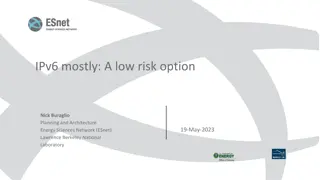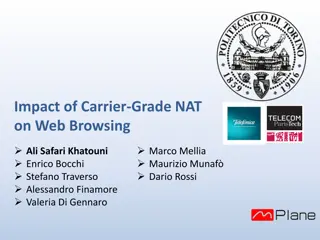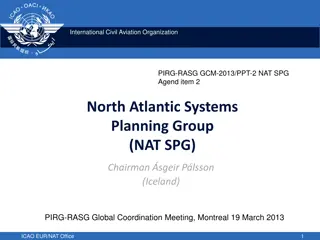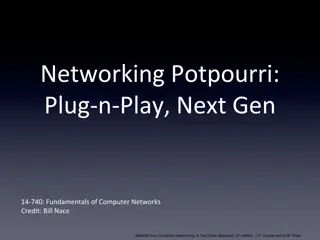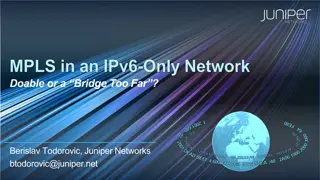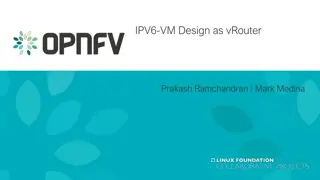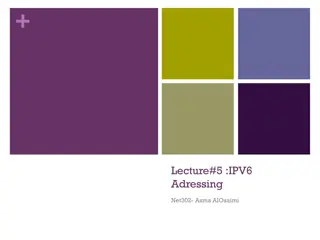NAT and IPv6 in Computer Networking
This lecture covers Network Address Translation (NAT) and IPv6 basics in computer networking. It explains how NAT helps in connecting multiple devices to the internet with limited IPv4 addresses, the concept of public and private IP addresses, and the transition to IPv6 for addressing constraints. Various diagrams and slides are used to illustrate key concepts such as subnetting, DHCP, IP routing, and the differences between public and private IP addresses.
Uploaded on Oct 10, 2024 | 1 Views
Download Presentation

Please find below an Image/Link to download the presentation.
The content on the website is provided AS IS for your information and personal use only. It may not be sold, licensed, or shared on other websites without obtaining consent from the author.If you encounter any issues during the download, it is possible that the publisher has removed the file from their server.
You are allowed to download the files provided on this website for personal or commercial use, subject to the condition that they are used lawfully. All files are the property of their respective owners.
The content on the website is provided AS IS for your information and personal use only. It may not be sold, licensed, or shared on other websites without obtaining consent from the author.
E N D
Presentation Transcript
1 CS-340 Introduction to Computer Networking Lecture 9: NAT and IPv6 Steve Tarzia Many diagrams & slides are adapted from those by J.F Kurose and K.W. Ross Many diagrams & slides are adapted from those by J.F Kurose and K.W. Ross
2 Last Lecture: IPv4 Addressing IP routing gets packets to their destination on the net. Each router has a forwarding table mapping addresses outbound links. Uses longest prefix matching. IPv4 fragments packets larger than MTU. Are reassembled at the destination. IPv4 header is 20 bytes (UDP header is 8 bytes or TCP header is 20 bytes) IP subnets define ranges of address that can communicate directly CIDR notation (123.100.16.0/28) specifies a range of addresses Used both for specifying subnets and for routing rules. /28 or 255.255.255.240 is called a subnet mask. Host s IP configuration is: address, subnet mask, gateway, and DNS server Gateway is IP address of the router who will route packets outside the subnet DHCP allows newly-arriving machines to request an IP configuration.
3 Network Address Translation (NAT) IPv4 addresses are in short supply (4 billion). ISP often will give you just one address, so how to connect multiple devices? Key insight: OS already shares one IP address with multiple independent processes running on one machine, using port numbers. STOP and THINK Make the entire local network look like one big host: Public ports map to local_IP_address, port pairs on the local network. NAT router must track this mapping and translate IP addresses on packets leaving/entering local network.
4 Public Internet Private LAN Looks like one big 35.10.3.7 to outside world
5 Public/Private address translation: Source address is private Dest. address is public Translate private to public Source address is public Dest. address is public Source address is public Dest. address is public Translate public to private Source address is public Dest. address is private
6 Private versus public IP addresses Public IP addresses specify locations on the Internet. Internet is sometime called the wide-area network (WAN) Eg: front-end servers, university campus, home router WAN Only one machine has the public IP address 54.245.121.172 Private IP addresses are meaningful only on a local network. Called local-area network (LAN) Eg.: home, office, back-end server Usually behind a NAT, to give hosts access to the Internet. Always within: 10.0.0.0/8, 172.16.0.0/12, or 192.168.0.0/16 Eg., millions of machines have the private IP address 192.168.0.100
NAT high-level view 7 Local 10.0.0.0/24 subnet is not part of the public Internet. Outgoing packets can reach destination easily Incoming packets must somehow be routed to the correct local machine. How? rest of Internet local network (e.g., home network) 10.0.0/24 10.0.0.1 10.0.0.4 10.0.0.2 138.76.29.7 10.0.0.3 datagrams with source or destination in this network have a 10.0.0.0/24 address for source, destination (as usual) all datagrams leaving local network have same single source NAT IP address: 138.76.29.7, different source port numbers for different local machines
8 NAT implementation NAT router takes these actions: Outgoing datagrams: replace (source IP address, port #) of every outgoing datagram to (NAT IP address, new port #). Remote host will respond using (public NAT IP address, new port #) as destination address. Remember (in NAT translation table) every (source IP address, port#) to (NAT IP address, new port #) translation pair. Incoming datagrams: replace (NAT IP address, new port #) in dest fields of every incoming datagram with corresponding (source IP address, port #) stored in NAT table.
9 NAT example 2a: NAT router randomly chooses the unused public port 5001 for the connection, and stores the translation. NAT translation table WAN side addr LAN side addr 138.76.29.7, 5001 10.0.0.1, 3345 1: host 10.0.0.1 sends datagram to 128.119.40.186, 80 2b: NAT router changes datagram source addr from 10.0.0.1, 3345 to 138.76.29.7, 5001 S: 10.0.0.1, 3345 D: 128.119.40.186, 80 10.0.0.1 1 S: 138.76.29.7, 5001 D: 128.119.40.186, 80 2 10.0.0.4 10.0.0.2 138.76.29.7 S: 128.119.40.186, 80 D: 10.0.0.1, 3345 4 S: 128.119.40.186, 80 D: 138.76.29.7, 5001 3: reply arrives dest. address: 138.76.29.7, 5001 3 10.0.0.3 4: NAT router changes datagram dest addr from 138.76.29.7, 5001 to 10.0.0.1, 3345
10 NAT difficulties Local clients can only be reached by public IPs that they recently contacted. In other words, cannot easily run services behind a NAT. Special NAT-router configuration called port forwarding determines where to send unsolicited packets. Some protocols (eg., SIP) advertise IP address and port in payload of packet, which will not be translated by NAT. Temporarily-inactive TCP connections may need to send keepalive packets that the NAT router does not forget the port mapping. NAT s port mappings timeout eventually to make room for later connections.
11 Peer-to-peer communication behind a NAT Neither of the two peers can be reached directly. NAT only works if private address contacts a public address. Private IP address cannot listen for new connections from Internet. NAT will discard any inbound packets not associated with an already- established connection. 10.0.0.5 Listening for a call But I m not reachable! 10.0.0.3 Starts a call Dropped! The Internet (public addresses) 138.76.29.7 NAT STOP and THINK NAT router 59.6.3.90 router Ideas to fix this problem?
12 Peer-to-peer NAT solution: Both parties must communicate through a relay server. Relay does no processing, so it can handle lots of traffic But, it s no longer a truly P2P, self-scaling system. Need to add more relays as service grows. STOP and THINK Must both clients connect to the same relay? 2. connection to a relay initiated by another NATed host. 10.0.0.3 10.0.0.5 1. connection to a relay initiated by NATed host. 4. conversation occurs through relay. NAT router 59.6.3.90 138.76.29.7 NAT router 3. both NATs are now willing to accept packets from their relay and forward them to the private hosts.
13 Other benefits to NAT (besides sharing scarce addresses) Security: local devices are not publicly reachable by strangers. For an outside IP address to contact a local device, the local device must first send a packet to that outside address, causing the NAT to create a new public port mapping for the connection. Configuration isolation: ISP and public IP address can change without reconfiguring local devices. Load balancing*: NAT can be used to make several servers work in parallel to handle work destined for one IP address. However, LB NAT works slightly differently that home NAT: Create entries in the translation table in response to new inbound requests from the public.
14 NAT Load Balancer (for scaling and fault tolerance) A type of NAT device that proxies requests to multiple equivalent servers. Load balancer maintains IP address and port mappings, like a traditional NAT. Makes multiple servers (with private IP addresses) appear like one big machine with one IP address. Allows a single IP address to handle lots of requests: port mapping and relaying is easy, whereas responding to requests may require lots of computation or I/O. Load balancer may monitor health and load of servers to inform its choice of server. Called a "layer 4" (TCP/UDP) load balancer. Client 1 4.4.4.4:1230 Client 3 6.6.6.6:9012 Client 2 5.5.5.5:3021 2.2.2.2:80 Load Balancer 10.0.0.1:1002 10.0.0.1:2302 10.0.0.1:5021 10.0.0.2:80 Server A 10.0.0.3:80 Server B
15 Multiple kinds of load balancers NAT LB forwards individual packets and just maps ports. HTTP Reverse Proxy relays full HTTP requests. DNS LB directs users to different IP addresses. IP Anycast assigns one IP address to multiple machines around the world, and the closest one accepts the traffic (covered in next chapter). Content Delivery Networks (CDNs) combine these two. Take CS-310 Scalable Software Architectures for more details on LBs.
16 Middleboxes Middleboxes are the category of network devices that transform, filter, or inspect packets but are not routers (not just forwarding). Eg.: Network Address Translators (NATs) Load Balancers Firewalls drop traffic using simple rules: Certain ports or source addresses may be blocked. Eg., censor a domain. Deep Packet Inspection firewalls looks for app-specific behavior. For example, access Wordpress admin page with HTTP GET /wp-admin Censor certain search terms on a permitted website. Intrusion Detection Systems (like firewalls, but more long-term) Gather traffic information for offline analysis to detect multi-step attacks.
17 Intermission
18 IPv6 A much better solution than NAT for the IPv4 address shortage. Uses 128-bit addresses instead of 32-bit. Expressed in hex: a39b:239e:ffff:29a2:0021:20f1:aaa2:2112 Invented in early 1990s when IPv4 address shortage was foreseen. 27 years later, IPv6 is slowly being adopted. But IPv4 is still the standard, with NAT being used extensively.
19 Adoption of IPv6: https://www.google.com/intl/en/ipv6/statistics.html
20 IPv6 address notation rules Groups of zeros can be replaced with :: Can only use :: once Leading zeros within each 16-bit group can be omitted. 0000:0000:0000:0000:0000:0000:0000:0001 ::1 (localhost) 2345:1001:0023:1003:0000:0000:0000:0000 2345:1001:23:1003:: aecb:0222:0000:0000:0000:0000:0000:0010 aecb:222::10
32 bits IPv4 datagram 21 IP protocol version type of service head. len. ver length fragment offset 3 fields for fragment- ation QoS/ECN flags 16-bit identifier time to live 32 bit source IP address upper layer header checksum max number remaining hops (decremented at each router) 32 bit destination IP address TCP/UDP/ICMP options (if any) e.g. timestamp, record route taken, specify list of routers to visit. how much overhead? 20 bytes of IPv4 20 bytes of TCP = 40 bytes + app layer overhead data (variable length, typically a TCP or UDP segment)
22 IPv6 datagram format Priority: like type of service in IPv4. Flow label: ambiguous Next header: TCP, UDP Hop limit = TTL flow label version priority hop limit payload length next header source address (128 bits) destination address (128 bits) data (variable length, typically a TCP or UDP segment) how much overhead? 40 bytes of IPv6 20 bytes of TCP = 60 bytes + app layer overhead 32 bits
23 Other improvements in IPv6 Checksum field was dropped Checksum already exists above in TCP/UDP & below in Ethernet. TTL is decremented at each router, so each router must recalculate checksum! Fragmentation support was dropped Routers should be simple and fast, let endpoints deal w/fragmentation (TCP) But extra 20 bytes header overhead of IPv6 is a tough pill to swallow. No real incentive to adopt IPv6 if you already have enough addresses.
24 IPv4 and IPv6 interoperability Internet is too large, important, and disorganized to force everyone to upgrade simultaneously to IPv6. Current Internet is a mix of IPv4 and IPv6 routers. Tunneling puts one protocol inside the payload of another: IPv6 header fields IPv4 header fields IPv6 source dest addr IPv4 source, dest addr UDP/TCP payload IPv6 datagram (IPv4 payload) IPv4 datagram Either IPv4 inside IPv6 or IPv6 inside IPv4
25 Tunneling illustration Green routers are tunnel endpoints IPv4 Internet Does not have an IPv6 address. Can send/recv only IPv4 packets Has both an IPv4 and IPv6 address IPv6 Subregion IPv6 Subregion Tunnel provides access to the entire IPv6 Internet. IPv6-only region Has no IPv4 address, so cannot communicate with IPv4-only hosts.
Tunneling example IPv4 tunnel connecting IPv6 routers 26 A B E F logical view: IPv6 IPv6 IPv6 IPv6 C D A E B F physical view: IPv6 IPv6 IPv6 IPv6 IPv4 IPv4 src:B dest: E src:B dest: E flow: X src: A dest: F flow: X src: A dest: F Tunneled packet is addressed between routers. Receiving router unpacks the IPv6 packet. Adds overhead: extra header bits extra processing flow: X src: A dest: F flow: X src: A dest: F data data data data A-to-B: IPv6 E-to-F: IPv6 B-to-C: IPv6 inside IPv4 B-to-C: IPv6 inside IPv4
27 How do IPv6 hosts talk to IPv4 hosts? IPv6 is not backward compatible with IPv4. The true IPv6 Internet is physically a bunch of islands Tunneling joins those islands with IPv4 Dual stack hosts are configured for both IPv4 and IPv6. These hosts have two IP addresses. DHCP request gives IPv4 address, and DHCPv6 request gives IPv6 address. IPv6 access network (ISP) must be a dual-stack network to give customers full access to the Internet. DNS AAAA (quad A) records list IPv6 addresses for hosts. When connecting to www.google.com, a dual-stack client will make both DNS A and AAAA requests, to find both an IPv4 and IPv6 addresses (if any). If there is no AAAA record, then fall back to IPv4.
28 RFC 6555: Happy Eyeballs Dual Stack Tunneling can make IPv6 slower than IPv4, so some clients will simultaneously try both IPv4 and IPv6 and use whichever connection completes the TCP handshake first: DNS Server Client Server | | | 1. |<--www.example.com A?-----| | 2. |<--www.example.com AAAA?--| | 3. |---192.0.2.1------------->| | 4. |---2001:db8::1----------->| | 5. | | | 6. | |==TCP SYN, IPv6=======>| 7. | |--TCP SYN, IPv4------->| 8. | |<=TCP SYN+ACK, IPv6====| 9. | |<-TCP SYN+ACK, IPv4----| 10. | |==TCP ACK, IPv6=======>| 11. | |--TCP ACK, IPv4------->| 12. | |--TCP RST, IPv4------->| Packet 12 cancels the IPv4 connection because IPv6 ACK ed first.
29 IPv6/IPv4 interoperability summary IPv6 IPv6: normal operation IPv4 IPv4: normal operation IPv6 (through IPv4 network) IPv6: tunneling IPv4 (through IPv6 network) IPv4: tunneling IPv4 IPv6: Not directly possible! Use dual-stack config with IPv6 IPv6 IPv4: Not directly possible! Use dual-stack config with IPv4 Further reference: https://pdfs.semanticscholar.org/34bb/2f946f83b656c6989d42fe043bf5f259b514.pdf
30 How to find an IPv6 tunnel endpoint? Large organizations operating multiple IPv6 islands will set up their own tunnels. Organizations may also peer with each other by configuring tunnels. Smaller organization may use a tunnel broker to access the IPv6 Internet: Hurricane Electric (a Tier 1 ISP) operates a free tunnel broker service: https://tunnelbroker.net/ This lets you start using IPv6 at home even if your ISP is not IPv6 enabled! But if your IPv4 address changes, then the tunnel must be reconfigured.
31 Recap Private networks are isolated from the public Internet, but usually connected through a Network Address Translator (NAT). Port mapping makes multiple machines on the private subnet look like multiple sockets (processes) on one big machine. NAT requires no awareness or cooperation from hosts on either side. NAT is also one way to implement a load balancer. Besides NATs, middleboxes include firewalls and other security appliances. IPv6 uses 128-bit addresses for practically unlimited public addresses. IPv6 adds 20 bytes of header overhead. Not directly compatible with IPv4. Adopted by ~30% of end hosts. Dual-stack hosts have both IPv4 and IPv6 addresses to reach entire Internet. Interoperates with IPv4 via tunneling: sendIPv6 packet inside IPv4 packet.







